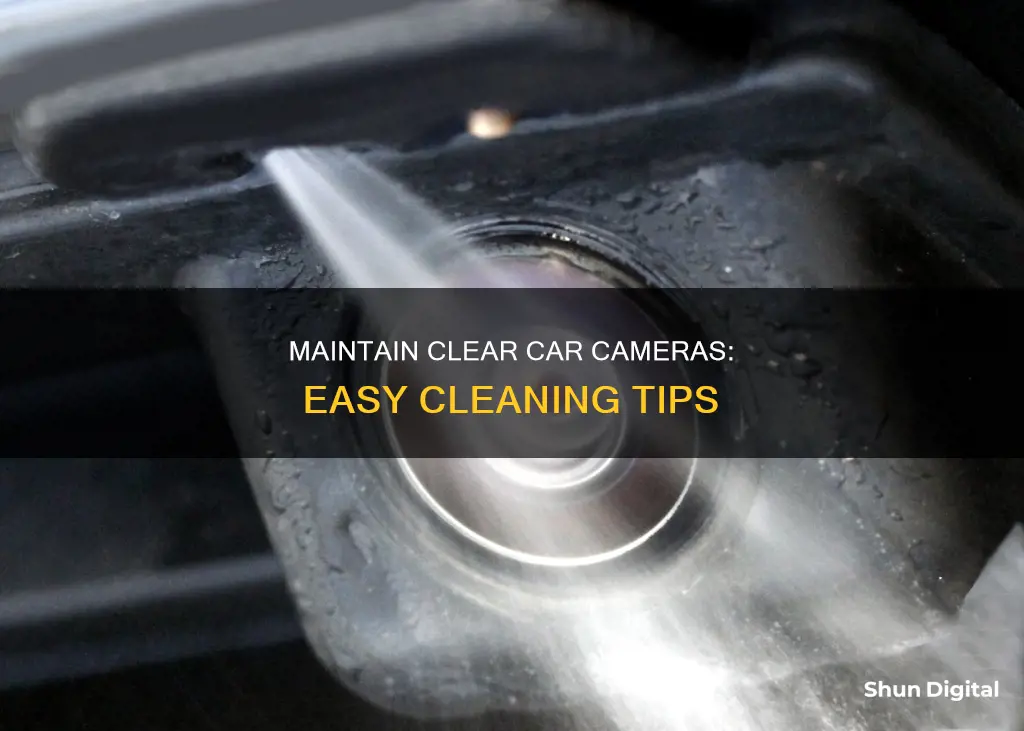
Keeping your car's backup camera clean is an important but often overlooked aspect of car maintenance. A dirty camera lens can obscure your view, making it difficult to safely navigate and park your car. To prevent this, it's recommended to clean your camera lens regularly, especially after driving through dusty, snowy, or muddy conditions. One way to keep your backup camera lens clean is to use a lens protector, such as the UkkoCam backup camera lens protector, which is a clear, durable film that repels water and dirt. Another option is to use a lens cleaning solution, such as isopropyl alcohol, applied with a soft cloth or microfiber cloth. Additionally, some car owners have suggested using products like Rain-X or silicone spray to help keep the lens clean. However, it's important to avoid cleaners with acetone as they can erode protective coatings on the lens.
How to Keep Car Cameras Clean
| Characteristics | Values |
|---|---|
| Location of the camera lens | Often located just above the license plate. In some cases, the lens is tucked under a lip or ridge in the car’s body to protect it from rain. |
| Tools | Soft-bristled brush or microfiber cloth, soft cloth, lens cleaner, water, isopropyl alcohol, car wax, silicone spray, Rain-X |
| Techniques | Wipe the lens with a soft cloth and isopropyl alcohol or water. Use a soft-bristled brush or microfiber cloth to wipe away dust and grime, then spray with a cleaner and wipe again. Apply car wax or Rain-X to repel dirt and water. |
| Cleaning frequency | Depends on driving frequency and road conditions. Wipe the lens after each drive in messy road conditions. |
What You'll Learn

Use a soft cloth with isopropyl alcohol to wipe away dirt
Keeping your car camera clean is essential for maintaining clear and crisp image quality. One effective method is to use a soft cloth with isopropyl alcohol to wipe away dirt, grime, and other contaminants. Here's a step-by-step guide on how to do it properly:
Firstly, ensure you have the right materials. You'll need a soft microfiber cloth and some isopropyl alcohol. The microfiber cloth should be clean and free of any dirt or debris. It's important to avoid using fabric softener when washing the cloth, as it can leave streaks on the lens and damage the lens coating.
Next, prepare the cleaning solution. Pour a small amount of 99% isopropyl alcohol into a spray bottle and fill the rest with distilled water. Shake the bottle gently to mix the solution. Alternatively, you can use lens cleaning fluid designed specifically for optical surfaces.
Before you start cleaning, park your car in a shaded area, preferably in a garage, to avoid direct sunlight, which can cause the solution to dry too quickly and leave streaks.
Now, you're ready to begin cleaning. Lightly spray the microfiber cloth with your chosen cleaning solution. Gently wipe the camera lens, using a circular motion, starting from the outer part of the lens and working your way towards the centre. Be careful not to apply too much pressure, as this can damage the lens.
After you've wiped the entire surface, use a clean, dry section of the microfiber cloth to remove any remaining moisture. This step is crucial, as it ensures that no streaks or water spots are left behind.
Finally, inspect the camera lens to ensure all dirt and grime have been removed. If necessary, repeat the process until the lens is completely clean.
Remember to clean your car camera regularly, especially if you drive in harsh weather conditions or on dusty roads. This simple maintenance routine will help you maintain clear visibility and keep your camera in good condition.
By following these detailed instructions, you can effectively use a soft cloth with isopropyl alcohol to wipe away dirt and keep your car camera clean.
Camera Stabilization: Power Drain or Creative Gain?
You may want to see also

Clean with water and a cloth
Keeping your car's camera clean is essential for your safety and that of others. A dirty backup camera can be even more dangerous than reversing without one at all, as it can give you a false sense of confidence.
Firstly, ensure you are using the right type of cloth. A soft, microfiber cloth is ideal for this task. It is important to avoid using any abrasive materials, as these can damage the camera lens.
Next, prepare the cloth by dampening it with water. You do not want the cloth to be dripping wet, so be sure to wring it out before proceeding.
Before you begin cleaning, it is a good idea to use a soft-bristled brush or the microfiber cloth to wipe away any loose dust, dirt, or debris. This will ensure that you do not scratch the lens when wiping it with the damp cloth.
Now, gently wipe the lens with the damp cloth, using gentle circular motions. Take your time with this step, as you do not want to leave any streaks or water marks on the lens.
Finally, dry the lens by buffing it with a dry, soft cloth. Again, use gentle circular motions to avoid any streaking, and ensure the lens is completely dry before you finish.
By following these simple steps, you can effectively clean your car's camera lens with water and a cloth, ensuring optimal visibility and safety.
Charging Camera Batteries: Empire Adapter Instructions
You may want to see also

Apply a lens protector film
Keeping your car cameras clean can be a challenge, especially when dealing with snow, ice, and road salt. While there is no perfect solution, here are some tips for applying a lens protector film to help keep your car cameras in good condition:
Choose the Right Film
Select a film that is specifically designed for camera lenses, such as a hydrophobic lens cover or a clear paint protection film. You can find these products online or at automotive stores. Make sure the film you choose is compatible with the shape and size of your camera lens.
Prepare the Lens
Before applying the film, thoroughly clean the camera lens and the surrounding area. Use a microfiber cloth and a lens cleaning solution or water to remove any dirt, dust, or grime. Ensure the lens is completely dry before proceeding.
Apply the Film
Cut the film to the appropriate size and shape, allowing for a slight overlap around the edges of the lens. Carefully remove the adhesive backing and position the film directly onto the lens. Use a soft cloth or squeegee to smooth out any air bubbles and ensure a secure fit.
Maintain the Film
Periodically check the condition of the film and clean it as needed. Avoid using abrasive cleaners or tools that could scratch the film. If the film becomes damaged or cloudy, replace it with a new one.
Other Considerations
In addition to applying a lens protector film, you may also want to consider other methods to keep your car cameras clean. For example, you can use a spray bottle with water or a lens cleaning solution to gently rinse away dirt without touching the lens. You can also install a rear window wiper or relocate your camera inside the vehicle, if possible, to reduce the amount of dirt and grime buildup.
Remember, even with a lens protector film, it is still important to regularly clean your car cameras and their surrounding areas to maintain optimal performance and visibility.
Fixing Camera Mirroring: Stop Your Computer Camera's Reversal
You may want to see also

Use a soft-bristled brush to wipe away dust
Using a soft-bristled brush is an effective way to wipe away dust and dirt from your car camera lens. It is an essential item in your camera cleaning kit, alongside a microfiber cloth and cleaning solution.
Firstly, before touching the lens with the brush, ensure the bristles are free from oil. If your fingers are oily, avoid touching the bristles as this will transfer the oil to the lens. A soft-bristled brush made from camel or goat hair is ideal for keeping your camera lens scratch-free during the cleaning process.
With the brush ready, gently sweep the bristles over the lens, using very gentle sweeping actions from one side of the lens to the other. It is important not to push down too hard on the brush as this could cause a larger piece of dirt to become stuck in the bristles and scratch the lens.
A soft-bristled brush is particularly useful for removing stubborn dust and dirt particles that a blower won't remove. It can also get into the tight grooves around the edges of the lens, ensuring a thorough clean.
After brushing, be sure to give the brush a thorough clean to ensure it is ready for next time.
Camera Battery Exhausted: What to Expect and Why
You may want to see also

Check for condensation behind the lens
Condensation can occur when there are dramatic changes in temperature or humidity, or when your camera is unprotected from elements like rain or snow. This can happen when moving between environments with differing temperatures, such as from outside in the cold to the inside of a heated car.
To check for condensation behind the lens of your car camera, first park your car in a warm place, like a heated garage. Then, turn on the heater and direct it at the camera lens. Do not put the heater on full blast; you want a gradual increase in temperature. This process may take some time, from 15 minutes to an hour.
If you are at home, try using a hairdryer on low heat. Be sure to keep the hairdryer moving so that the heat is not concentrated on any one spot.
If your lens is still foggy, place your camera in an airtight bag and remove as much air as possible. Put something in the bag to absorb moisture, such as uncooked rice or a silica gel packet. Leave the camera until it reaches the surrounding temperature and all condensation has disappeared.
To prevent condensation from forming, you can try to regulate temperature changes by placing your camera in a well-padded camera bag and closing all zippers before moving between environments with differing temperatures. You can also place your camera inside a plastic ziplock bag before putting it in your camera bag for extra protection.
Surveillance Cameras: Boston Bomber's Downfall
You may want to see also
Frequently asked questions
First, locate the camera lens. It's often above the license plate or at the top of the hatchback. Use a soft-bristled brush or a microfiber cloth to wipe away dust and grime. Then, spray with a lens cleaner and wipe in gentle circular motions.
You can use specially formulated lens cleaners, or a cheap, effective solution such as isopropyl alcohol. Avoid cleaners with acetone as a primary ingredient, as it can erode protective coatings on the lens.
This depends on how often you drive and the road conditions. In messy weather, it's a good idea to wipe the lens after each drive.
You can apply a clear, durable patent-pending film over the camera lens, such as a UkkoCam backup camera lens protector. This film repels water and dirt, making it easier to clean the lens.
A blurry camera display could be due to an issue with the system's wires and connections. Check for any signs of damage, such as split or disconnected wires. You can also check your vehicle's fuse box to rule out a blown fuse.







